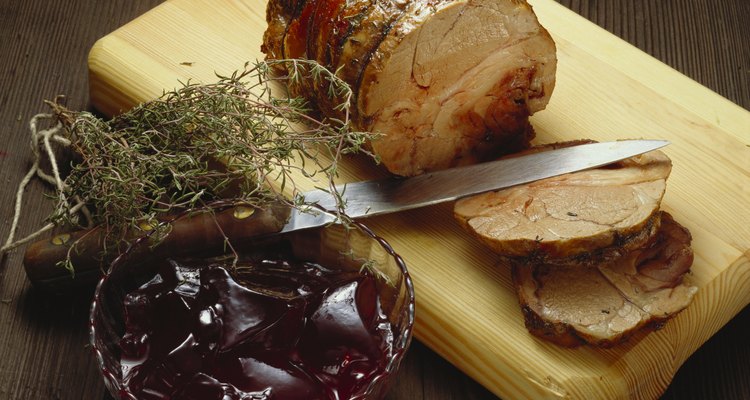
A pork roast offers delicious answers to what's for dinner. Some cooks hesitate to plan a meal around a roast because of the other frequent question about dinner: when. For a tightly scheduled family, cooking a roast may seem suitable only for special occasions. High-heat roasting, popularized in the 1990s, offers a possible way to shorten cooking time. Using it for a pork roast raises questions you will want to explore.
High-Heat Roasting
Popularized by Barbara Kafka in the 1990s, high-heat roasting raises oven temperatures to 500 degrees Fahrenheit. At this temperature, the outside of the meat sears, much as it would on a grill or in a skillet, sealing juices inside. According to Kafka, this technique lets you cook a 3 1/2-pound pork loin roast in just under one hour. Similar results can be obtained with the oven at 450 degrees, and recipes tend to specify an internal temperature of 150 degrees as done.
Conventional Roasting
Changes in how pork is raised, combined with increased knowledge about the effect of heat on meat pathogens, stimulated the United States Department of Agriculture to change its safe-temperature guidelines for cooking pork in 2011. Pork is now regarded as safe to eat when it has reached an internal temperature of 145 degrees Fahrenheit, rather than the previous 160 degrees. Guidelines still assume an oven temperature of 350 degrees, but cooking times have decreased because of the new rules on doneness. The standard USDA-based timetable for cooking pork specifies a roasting time of 20 minutes per pound. On these terms, a 3 1/2-pound pork loin would cook in approximately 1 hour and 10 minutes.
Evaluating Roasting Methods
Clearly some time can be saved by roasting pork at a high heat. A 3 1/2-pound roast can be cooked in approximately 55 minutes at high heat, instead of 70 minutes at conventional temperatures. Cooking at 450 to 500 degrees Fahrenheit for an hour or more, however, can create substantial kitchen heat and, depending on ventilation, smoke as well. As a comparison, frying temperatures for pork and other meats in a covered electric skillet range between 275 and 400 degrees. Cooking at higher heat also means more careful monitoring of your roast's progress. Only a few minutes will make a difference between done and overdone. Reducing a roast's cooking time from over to under an hour, however, may make exactly the difference you need in meal-preparation time. The final determinant may be what else you plan to do with your time while the roast cooks.
Controlling Roasting Results
Whichever method you choose, several factors play an important part in successful results. One is the internal temperature of your raw roast. Meat can be roasted directly from the refrigerator, but, if it has been previously frozen, you should make certain that thawing is complete. Especially for a cook in a hurry, preheating an oven may seem like a waste of time, but a stable temperature will shorten cooking time over starting a cold roast in a cold oven. A reliable meat thermometer, whether conventional or instant-read, is the ultimate authority on doneness. If you live at a high altitude, it is important to know that neither cooking method is affected.
Related Articles

Can I Cook a Roast Beef for Three Hours ...

Does Cooking at a Low Temperature for a ...

What Is a Picnic Roast?
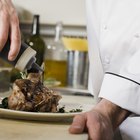
How Long Do You Cook Pork Chops in the ...

How to Make a Blackbuck Antelope Roast
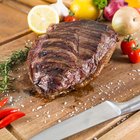
How to Cook 30 Pounds of Pork in a ...
How to Cook Pre-Seasoned Porketta

Cooking Times for Smoking Meat in an ...

What Is the Fastest Way to Cook Baked ...
Ideal Turkey Cooking Time by Weight
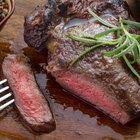
How to Cook a Seamed Eye Round

How to Know When Pork Roast Goes Bad

How to Cook a Standing Rib With the ...
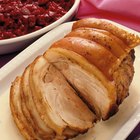
Does Cooking a Pork Roast Frozen Help ...
How to Smoke Center Cut Pork

How to Smoke a Ham in a Bradley Smoker

How to Slow-Cook Meat in the Oven

Baking Time for Marinated Beef Brisket

How to Smoke Pork on a Gas Grill

How to Cook Steak on a Baking Sheet
Resources
- National Pork Board: Pork Cooking Times
- Food Safety News: USDA's New Recommended Pork Cooking Temp: 145 degrees F
- Kitchen Riffs: Roast Pork
- National Pork Board: Italian Roast Pork Loin
- New Mexico State University Extension: High Altitude Cooking
- New York Times: Garlic Roast Pork Loin
- New York Times: Some Like It Hot: Roasting at 500 Degrees
- Presto Electric Skillet: Temperature Time Table
Writer Bio
Janet Beal has written for various websites, covering a variety of topics, including gardening, home, child development and cultural issues. Her work has appeared on early childhood education and consumer education websites. She has a Bachelor of Arts in English from Harvard University and a Master of Science in early childhood education from the College of New Rochelle.
Photo Credits
Eising/Photodisc/Getty Images